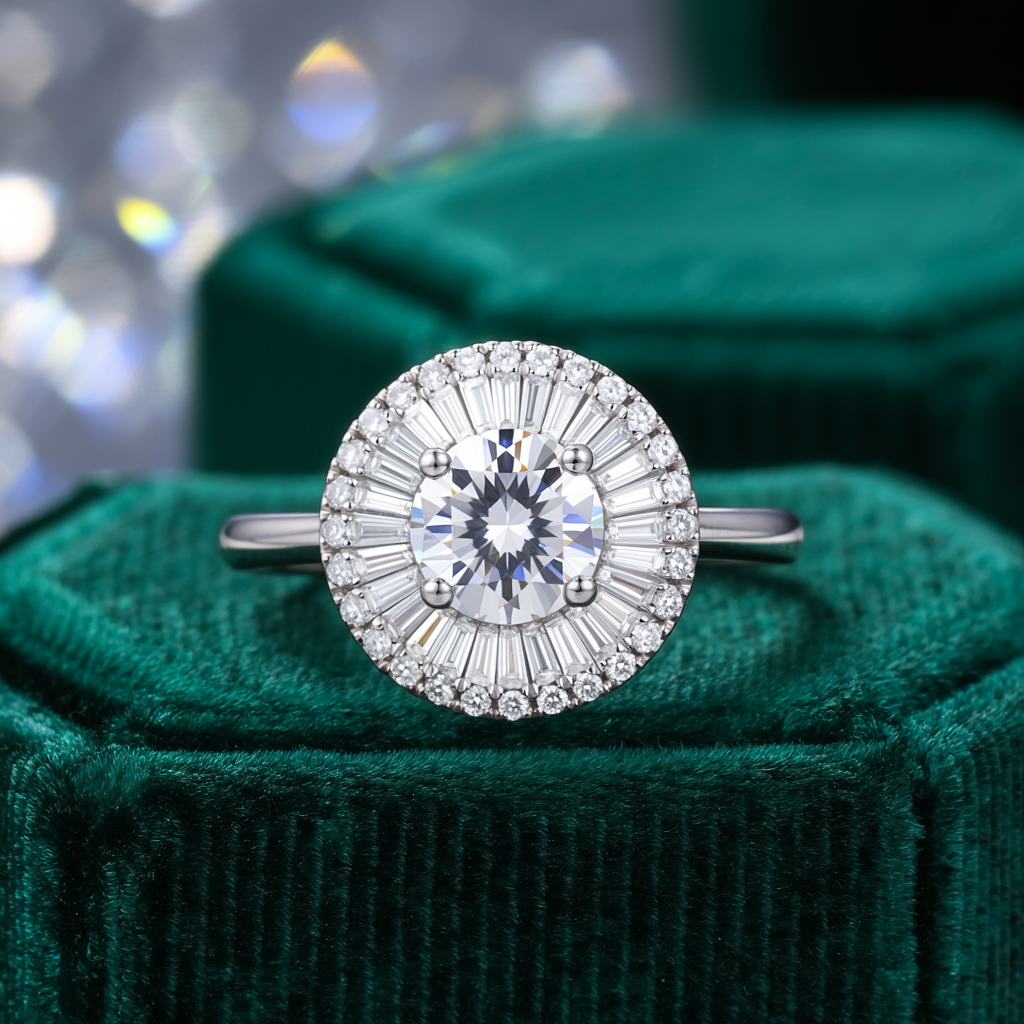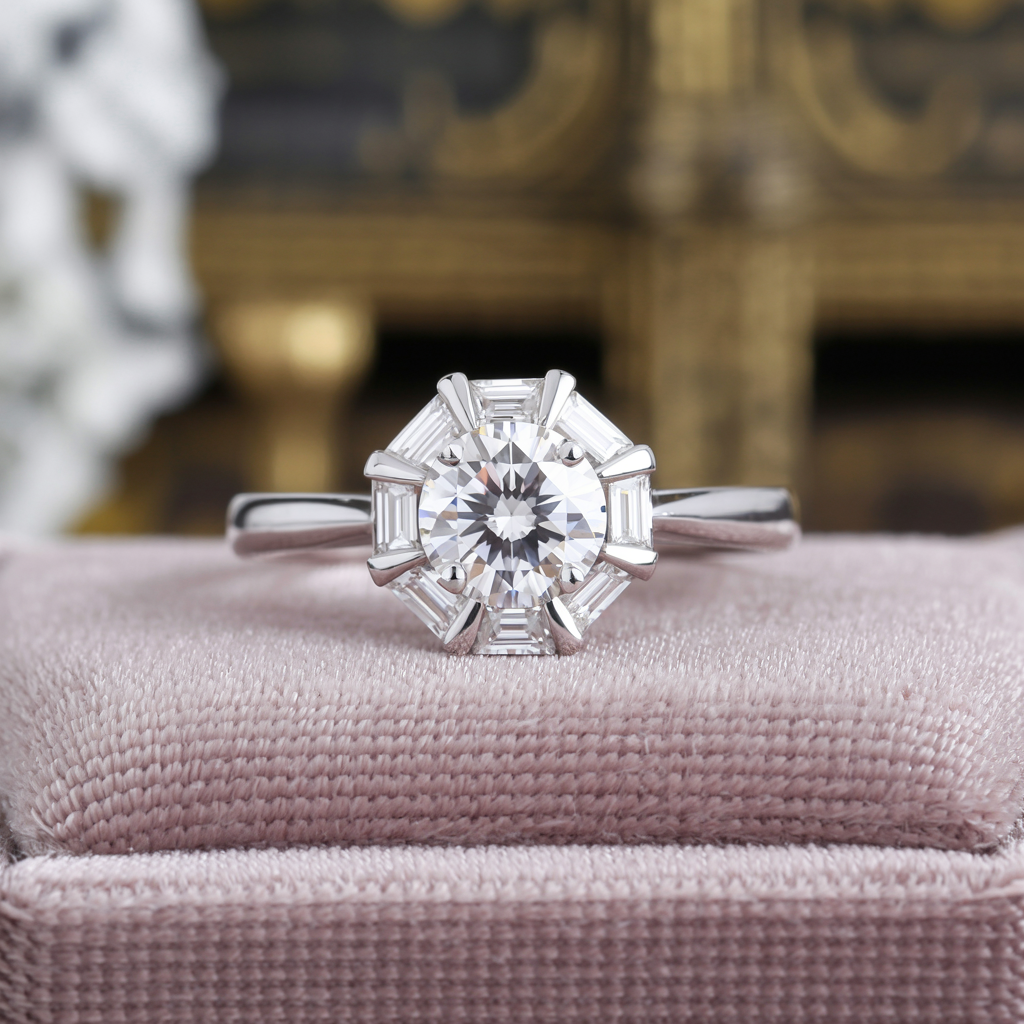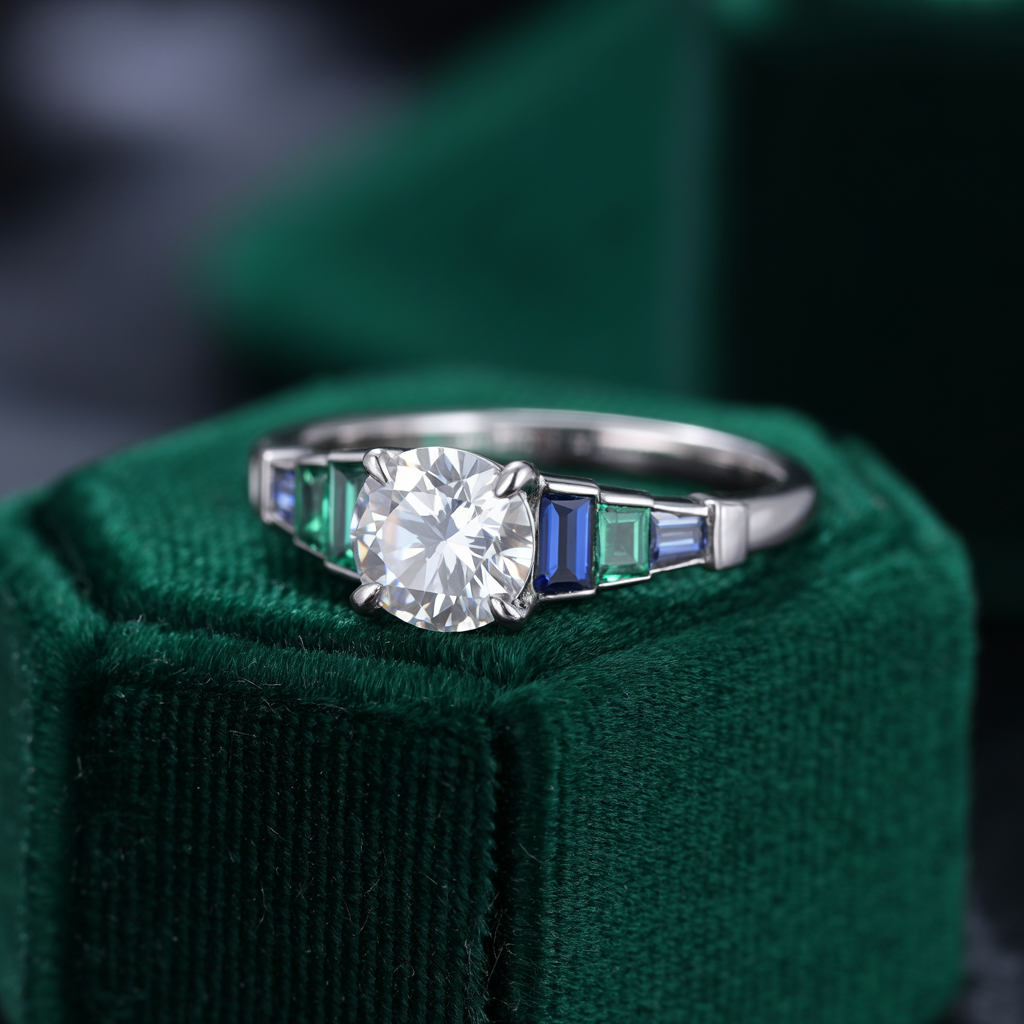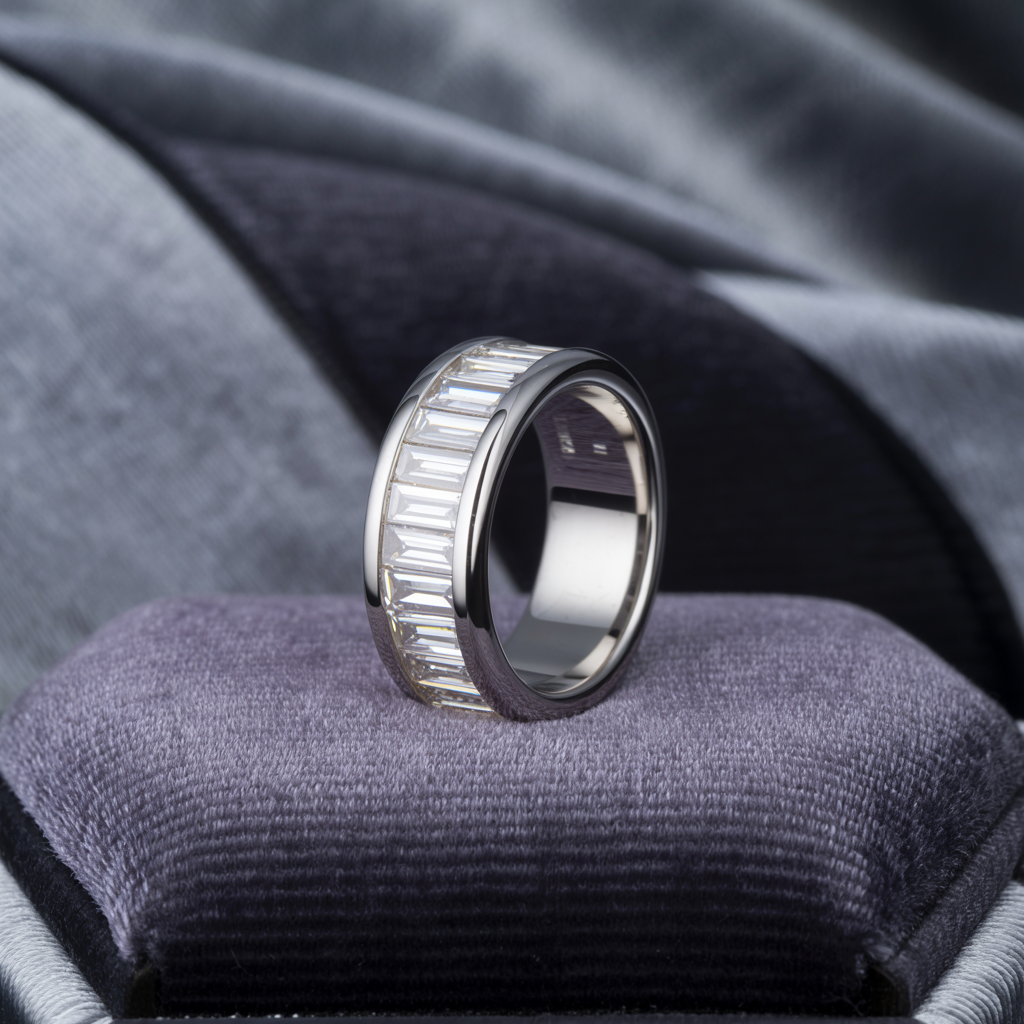Timeless 20 Baguette Engagement Rings: Unique Styles You’ll Love
Baguette Engagement rings often speak louder than words. They tell a story of taste, values, and the weight of commitment. While brilliant rounds dominate the market, there is a different path — the baguette engagement rings. Its geometry is deliberate, its light is restrained. Instead of chasing sparkle, the baguette cut pursues clarity, symmetry, and architectural beauty. The name “baguette” comes from the French word for a long, thin loaf of bread — not accidental. These stones are elongated rectangles, sometimes tapered, with step-cut facets. Unlike brilliant cuts, they do not scatter light wildly.
Minimalist Solitaire with Baguette Accent

Minimalism thrives when nothing extra distracts the eye. A solitaire diamond set with baguette accents is proof. Imagine a round or oval center stone. On each side, a straight baguette points toward it. The result is contrast: the flowing curves of the solitaire, the straight edges of the baguettes. This style is perfect for someone who values balance. It is still classic — a solitaire at its heart — but it sharpens the look with the geometry of baguettes. The accents do not compete. They frame. They give direction. Minimalist solitaires with baguette accents suit those who dislike clutter.
Vintage Baguette Cluster

Some designs look forward. Others look back. A baguette cluster ring belongs to the latter. Popular in the 1920s and 30s, this design gathers baguette engagement rings diamonds into patterns that resemble sunbursts, fans, or floral motifs. The effect is dramatic but rooted in order. A baguette cluster ring suits those who admire history. It pairs well with heirlooms, vintage fashion, or anyone who leans into Art Deco aesthetics. Structurally, clusters require careful craftsmanship. Each baguette must align perfectly, as even slight misplacement breaks the symmetry. The payoff is striking. A baguette cluster doesn’t sparkle like a brilliant cut but shines with an even, architectural glow.
Baguette Halo Design

The halo setting remains popular because it makes a center stone appear larger while adding brilliance. In most cases, the halo uses round diamonds. But when baguettes take their place, the effect changes dramatically. Picture a central diamond — perhaps round, oval, or emerald cut. Around it, a ring of baguettes forms a border. The straight edges of the baguette engagement rings create a halo that feels structured, almost architectural. Where rounds add soft sparkle, baguettes add sharp definition. This style appeals to someone who wants presence without excess glitter. The baguette halo frames the diamond like a work of art in a clean border. It feels deliberate, intentional, strong.
East-West Baguette Setting

Most baguette diamonds are placed vertically along the band. The east-west setting breaks this tradition. Here, baguettes lie horizontally, stretching across the finger. The look is modern, graphic, and slightly rebellious. This style works with both solitaire and multi-stone rings. A single horizontal baguette as the centerpiece makes for a sleek, minimalist baguette engagement rings. Multiple east-west baguettes aligned in a row create rhythm and flow, elongating the finger. For someone who avoids tradition, an east-west baguette setting is a subtle act of defiance. It rejects the norm while staying elegant. The result is a ring that whispers modernity without losing grace.
Three-Stone Baguette Engagement Rings

The three-stone baguette engagement rings has long symbolized past, present, and future. When baguettes are used, this symbolism gains structure. Picture a large central stone — round, emerald, or oval. On each side, a tapered baguette points toward it. This design balances meaning with geometry. The center diamond represents the main focus, while the baguettes echo commitment with clean, linear grace. Unlike round or pear side stones, baguettes do not overshadow. They direct attention inward. The beauty of this style lies in its proportion. Tapered baguettes ensure the design flows seamlessly into the band. Straight baguettes, by contrast, create a bolder, more abrupt frame. Both work, depending on taste.
Art Deco Baguette Frame

The Art Deco movement defined an era of design between the 1920s and 1930s. It celebrated symmetry, geometry, and bold architectural motifs. A baguette engagement rings in this style draws directly from that heritage. Imagine an emerald-cut diamond framed with baguette side stones, each aligned like building blocks of light. The setting resembles the facades of Deco skyscrapers — orderly, repeating, precise. Unlike soft, romantic designs, an Art Deco baguette ring delivers clarity and structure. Collectors and style purists gravitate toward this look. It’s not delicate, not whimsical. It is strong, even stern, yet beautiful. The focus lies in perfect alignment. Each baguette must sit tightly, with sharp corners creating a frame around the central stone.
Tapered Baguette Shoulders

Sometimes the strongest statement is subtle. Tapered baguette shoulders exemplify this. On either side of the center diamond, baguettes taper from wide to narrow, like arrows guiding attention inward. The effect: balance, focus, precision. This setting is among the most versatile. It works with nearly any center stone — round, oval, cushion, or emerald cut. The taper softens the transition from diamond to band, giving the ring an uninterrupted flow. From a technical standpoint, tapered baguette engagement rings require skilled craftsmanship. Each stone must be cut with slight variation so the taper aligns seamlessly. When done well, the result is effortless symmetry.
Emerald Cut with Baguette Band

Few pairings feel as natural as emerald cuts with baguettes. Both share the same step-cut faceting style. Both emphasize reflection over sparkle. Together, they create a ring that feels like a single, unified design language. Picture an emerald-cut diamond in the center, flanked by a band set with baguette stones. The eye moves seamlessly from center to shank, without clash. Instead of contrast, there is continuity. Straight lines meet straight lines. Durability is another strength. Baguette bands, especially in channel or bezel settings, are secure. They sit flush, reducing the risk of chipping or snagging. For someone who values clarity and cohesion, this design delivers. Emerald and baguette cuts together say one thing: discipline, harmony, and deliberate order.
Half-Eternity Baguette Band

Not every baguette engagement rings needs a dramatic centerpiece. Some are understated bands that speak through repetition. A half-eternity baguette band is one such design. Here, baguette diamonds line only the top half of the band. The rest remains plain metal. The effect is balance: sparkle on display, comfort and durability beneath. Unlike a full eternity, this design is easier to resize and maintain. Visually, the half-eternity baguette band is modern and refined. The stones sit flush, reflecting light in straight, mirror-like flashes. It appeals to minimalists — those who reject clutter and prefer order.
Full Eternity Baguette Band

Where the half-eternity stops, the full eternity begins. Baguette diamonds circle the entire band without interruption. No breaks. No end. Just a continuous sequence of clean lines. This design is uncompromising. It demands precision — every baguette engagement rings cut and set to align perfectly. It is also less practical. Resizing is difficult. Maintenance requires care. But for many, that sacrifice is worth it. The symbolism is powerful. A full eternity baguette band represents unbroken promise. It is relentless in its symmetry. On the finger, it feels like a closed circuit of light. For those drawn to clean geometry and permanence, no other ring carries the same weight. It is the essence of discipline, a circle without compromise.
Mixed Shape Contrast

Baguette diamonds thrive when paired with opposites. Their sharp, straight edges find balance beside curved or irregular cuts. Think of a round brilliant center stone flanked by baguettes. Or a pear-shaped diamond accented with clean rectangular side stones. The tension between the shapes creates visual interest. This style appeals to people who dislike predictability. They don’t want all parts of the ring to match. They want contrast. The baguette engagement rings bring order; the rounds or pears bring movement. Together, they form a dialogue between geometry and organic form. Symbolically, mixed shapes can represent balance in relationships. Opposites that complement, not clash.
Channel-Set Baguette Design

Channel setting is where baguettes shine. In this method, the diamonds are secured between two strips of metal, flush with the band. No prongs, no height. Just clean rows of light. A channel-set baguette ring is architectural in its simplicity. It feels like a continuous track, a smooth ribbon of diamond and metal. The stones reflect light in long, mirror-like flashes rather than glittery sparks. The result is subtle brilliance — precise, even, controlled. This design suits active wearers. The flush setting protects baguette edges from chipping, and the ring resists snagging. Practical and stylish.
Modern Bezel with Baguettes

Bezel settings wrap diamonds in metal, protecting their edges and giving the ring a modern industrial look. When baguettes join this style, the effect sharpens. Their straight lines complement the bezel’s solid outline. Picture a round or cushion-cut diamond held in a sleek bezel. On the band, flush-set baguettes echo the geometry. The ring looks modern, even futuristic, yet wearable. It’s bold without being flashy. This design suits minimalists who value security as much as style. A bezel with baguette engagement rings withstands daily wear better than prong settings. The stones are shielded, the edges safe.
Baguette Ring with Colored Stones

White diamonds dominate engagement ring traditions. But baguettes cut from colored stones break that mold. Imagine blue sapphires, green emeralds, or red rubies cut into sleek rectangles and set beside or around a center diamond. Colored baguette accents bring vibrancy while keeping order. Unlike round colored stones, which add softness, baguette engagement rings maintain structure. Their sharp edges keep the design disciplined, even when introducing bold color. From a design perspective, colored baguettes work best as accents. They frame the center diamond or create borders. But they can also stand alone, forming a full eternity of color. In every case, they shift the ring away from tradition into territory that feels personal, intentional, and striking.
Invisible-Set Baguette Mosaic

Invisible settings allow baguette engagement rings diamonds to sit tightly together with no visible prongs or metal between them. The result is a seamless mosaic of stones, almost like glass tiles in light. This style highlights the precision of baguettes. Each must be cut with extreme accuracy to lock into the invisible setting. When done correctly, the surface looks uninterrupted — a continuous sheet of diamond. Symbolically, the mosaic effect speaks of unity. Individual stones disappear into the whole. Together, they become something greater — a seamless reflection of commitment.
Asymmetrical Baguette Placement

Not every baguette engagement rings must follow symmetry. In fact, deliberate imbalance often creates intrigue. An asymmetrical baguette placement breaks the mold. Imagine a round or oval center diamond with baguette accents only on one side of the band. Or a design where baguettes of different lengths stagger like steps instead of aligning evenly. This look appeals to wearers who want individuality without chaos. The asymmetry is intentional, not sloppy. It makes the ring feel modern, less predictable, yet still grounded in structure. Craftsmanship plays a big role here. The jeweler must ensure the imbalance looks designed, not accidental. Angles, proportions, and alignment matter. Done poorly, it feels off. Done well, it feels like art.
Mixed-Metal Baguette Setting

Metal choice defines tone. Yellow gold feels warm and classic. White gold or platinum reads cool and modern. Rose gold adds romance. When metals are mixed in a baguette setting, the contrast highlights the linear beauty of the stones. This style suits those who dislike monotony. It also appeals to wearers who want versatility — a mixed-metal ring pairs well with both gold and silver jewelry. Symbolically, mixed metals can represent union. Different elements working together in harmony. It’s a subtle nod to partnership: distinct, yet cohesive.
Stacked Baguette Rings

Why stop at one ring? Stacking slender baguette bands creates a modular engagement style. Some wearers prefer a single stackable band as the engagement ring. Others pair two or three, mixing textures and metals. This idea appeals to modern minimalists. They reject the notion of a single fixed design. They want flexibility, adaptability, freedom. A stack of baguette rings delivers exactly that. From a design perspective, stacking demands restraint. Too many bands, and it becomes bulky. But with careful proportion, the result is sleek and powerful. Symbolically, stacking represents layers of commitment. Each band a step, each stone a memory. It’s a ring concept less about a single moment, more about a journey.
Sculptural Baguette Mounts

Some rings step beyond jewelry and into art. Sculptural baguette mounts transform the stone into architecture. Think of tiered platforms of baguettes rising toward the center stone. Or baguettes angled in stepped patterns, creating depth and dimension. This style is bold. It’s not for those who want subtlety. It’s for wearers who want their ring to command attention, not blend quietly into the hand. A sculptural baguette mount communicates confidence. The wearer is not afraid of presence. They see jewelry not only as ornament but as design, as statement. On the finger, it looks less like a ring and more like a small monument.
Heirloom Redesign with Baguettes

Jewelry often carries history. Heirloom stones — from a grandmother’s solitaire or a mother’s wedding band — can be reborn with baguettes. Resetting them into modern settings with baguette accents bridges past and present. Symbolically, heirloom redesign with baguettes is powerful. It transforms history into continuity. It proves that commitment is not static — it evolves, just like families do. On the hand, such a ring tells two stories at once: where one comes from, and where one is going.
FAQs About Baguette Engagement Rings
Are baguette engagement rings durable for daily wear?
Durability depends on cut, setting, and lifestyle. baguette engagement rings diamonds have straight edges and narrow ends, which can make them more vulnerable to chipping compared to round or cushion cuts. But that doesn’t mean they are fragile.
Do baguette engagement rings sparkle as much as round diamonds?
No — and that’s the point. Baguette cuts are step-cut, meaning they reflect light in long flashes rather than scattering it in fiery sparkles.
Are baguette engagement rings more expensive than other cuts?
Not usually. Because baguettes use simpler step cuts, they often waste less rough diamond than brilliant cuts. This efficiency keeps their prices lower, especially for smaller stones used as accents.
Can baguette engagement rings be resized easily?
It depends on the setting. Solitaire rings with baguette engagement rings accents can usually be resized by a skilled jeweler. Half-eternity bands may allow limited adjustment, but full-eternity baguette rings are difficult, sometimes impossible, to resize without disrupting the sequence of stones.
Do baguette engagement rings go out of style?
No. Their strength lies in timeless design. The baguette cut first gained popularity during the Art Deco era, nearly a century ago. Its appeal has never disappeared. Trends swing from minimalism to minimalism, from ornate to simple, yet baguettes endure.
Conclusion
Baguette engagement rings defy excess. They do not chase brilliance through endless sparkle. They stand instead on clarity, proportion, and form. Twenty ideas reveal their depth: solitaires sharpened with baguette shoulders, vintage Deco clusters, modern bezel settings, full eternity bands, sculptural mounts, and even heirloom redesigns. Each concept speaks the same language — geometry as beauty. Baguette engagement rings do not shout. They speak with restraint. On the hand, they are calm but commanding, austere but luminous. They prove that elegance is not always found in abundance — sometimes it is found in order, in balance, in the sharp line of a single cut diamond.






